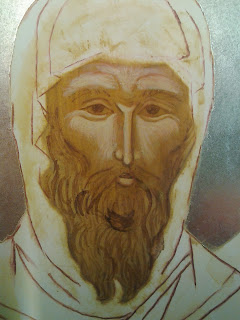Itse asiassa, ikonimaalari ei koskaan työskentele yksin. Mukanani on aina vähintäänkin kulloinkin maalattava pyhä, lisäksi varmasti Pyhä Henki tai... äh, en ole teologi, enkä lähde arvailemaan keitä siinä on paikalla. Työnaloitusrukouksessa käännytään mm. apostoli Luukkaan, ensimmäisen ikonimaalarin puoleen. Joskus, kun on kimurantti kohta, mutisen: Pyhä Andrei Rublev, rukoile minun puolestani, ennen kuin lasken siveltimen kärjen työlle. Ja yleensä apua on annettu. Joskus menee hieman pieleenkin, ja pitääkin mennä. Eihän sitä muuten opi.
Vaikkei ajattelisikaan näin konkreettisesti, symbolisesti takanani on koko taidehistoria, tyylikausineen ja tekniikoineen. Ennen ikoneita oli Kreikan ja Rooman taide, Kaksoisvirran maan ja Egyptin taide, jotka kaikki antoivat vaikutteita Bysantin taiteeseen. Ja aina kun hieron pigmenttiä esipiirroksen taakse siirtääkseni sen laudalle, ja kämmeneni värjäytyy maapunaisella, jokin minussa palaa kivikauden
luolamaalareiden luo.
Työ "ominpäin" maalattavan Pantokratorin parissa eteni melko ripeästi, kun sitkeä flunssa piti minut kotona päivisin. Oli rento ja luottavainen olo, työ rullasi eteenpäin kuin omalla painollaan - köhästä huolimatta. Lisäksi tuntui että päässä nalkutti "sisäinen ikonimaalauksen opettaja", sietämätön tyyppi, joka pani minut korjaamaan mitä milloinkin. Oikein etsimällä etsi kaikenlaista puolikelpoa, eikä antanut rauhaa, ennen kuin olin korjannut sen moitteettomaksi! Tässä alla on siunaavan käden taakse lisätty pala sinistä viittaa. Vietin illan tehden kuvahakuja netissä ja tulin siihen tulokseen, että tämän
himationin pitää näkyä käden yläpuolella, sillä kaikissa vanhoissa (ja/tai hyvissä) ikoneissa se näkyy! Minkäs teet?
Vertaile tämän tekstin viimeiseen kuvaan
Compare to the last picture in this post.
Hiusten ensimäinen vaalennosväri - First light color on the hair.
Toinen valo hiuksissa. Tämän jälkeen tulee lasuuri.
Second light on the hair. After this comes a glaze.
Ei paha. Katsotaan mitä maestro sanoo.
Not too bad. Let´s see how maestro likes it.
As a matter of fact, an iconographer never works alone. The saint you are painting is inevitably there. And the Holy Gost, I should think, and... erm, I am not a theologian, I better not guess who could be present. In the prayer I say before I start painting, apostle Luke, the first iconographer is mentioned. If there is a particulary difficult detail, I usually mumble "Holy Andrei Rublev, pray for me!" before I put the brush tip on the board. Usually help is given. Of course I make mistakes too, I must make them, in order to learn from them.
Thinking less concretely, I have the whole history of art behind me, with all it´s epochs and multitudes of techniques. Before the icons there was the art of the Greeks and Romans, the art of Mesopotamia and Egypt, all of these giving their influence to the byzantine art. Every time I rub earth red pigment behind a drawing in order to transfer it on a board, and my palm is dyed red too, I remember my
stone-age colleagues.
My work on my "all by myself" Pantokrator is advancing rapidly, because a stubborn flu, wich has kept me at home. Despite the coughing I have felt confident about what I have done, and been able to make the right decisions. I also seem to have acquired a "inner iconography teacher", a insufferable character, who seeks for mistakes and makes me redo things until they are perfect. Here above you find a picture of the blessing right hand. Behind it I added a bit of blue
himation. I spent a evening doing searches on the net and came to the conclusion that the himation must be visible above the hand, since all old and/or good icons shows it that way! What else can I do?












